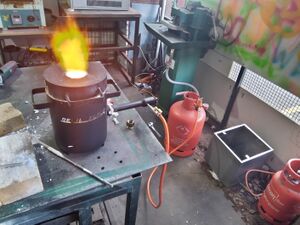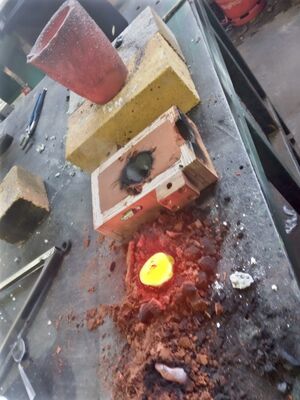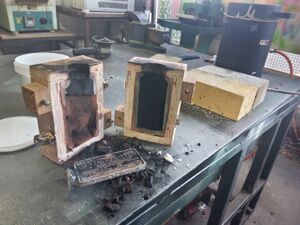Casting Furnace (Devil-Forge FB1S)
A propane-fuelled furnace used for melting metal for casting
This furnace can reach as high a temperature as 1450°C, hot enough to melt aluminium, brass, copper, silver and cast iron. It acts as the heavier-duty companion to the tabletop electric furnace.
To summarise the process of using it (full details will be given in training) - a crucible full of metal is lowered into the chamber and the gas ignited. By careful management of the air-fuel mixture the metal is bought up to melting temperature. Once liquid, the gas supply is shut off, lid opened, and the crucible lifted out and placed on an insulated surface. A teaspoon so of flux is added to bring out impurities which are then scraped off with a drossing spoon. The liquid metal is then poured into the appropriate mould.
So far we have tried out sand casting (typically with 3D-printed patterns). We are looking to expand to other methods such as lost wax/ lost PLA in the future.
User manual located here: File:Devil-Forge; User Manual (For Gas Forges).pdf
Accessories
The furnace alone is only part of what's required for casting, a whole range of accessories are required. The space can provide:
- A gas bottle (see charges)
- Welding gauntlets and full-face shield for protection
- Lifting tongs for lifting the crucible in and out of the furnace
- Pouring tongs for making the pour
- A drossing spoon for removing impurities
- Coming soon - moulding flasks for preparing sand castings
You will need to bring your own (if you are just starting out speak to the maintainers or other casting users, we may be able to lend you some to get you started):
- Metal for casting (scrap metal e.g. old brass plumbing fittings are probably the easiest source)
- Crucible (melting pot) - we recommend a clay-graphite crucible of 120mm diameter x 130mm tall, e.g. this eBay item (the 4kg version)
- Flux - borax is used for brass and cast iron, e.g. this eBay item
- Moulding material, usually sand - generally 'Deflt Clay' e.g. this eBay item
All links are valid as of 2022-03-07, if they are broken please use them as a guide to source something equivalent. Discuss with the maintainers if you need advice on what to buy.
Safety
Beyond all the usual workshop safety precautions there are some additional safety concerns specific to casting that should be understood. A few of the key points are set out below but this is not an exhaustive list:
- PPE - welding gauntlets, a full face shield, long sleeves (preferably of non-flammable material) and sturdy footwear are recommended for protection against splashes
- Handling crucibles - these are delicate and must not be rough-handled, dropped or squeezed too hard or they may shatter, with obvious consequences
- Fumes - molten metals can give off potentially dangerous fumes, especially brass which contains zinc. Using the furnace outdoors in the cage is an obvious mitigation but still avoid breathing fumes
- Metal content - scrap metal is usually the best source of material for casting but be wary of what you are putting in. In particular, any metal containing air pockets or trapped water is potentially very dangerous as both will explode if immersed into already molten metal while topping up a crucible. Any second-charge metals should be pre-heated on top of the furnace lid to drive out any retained moisture
Training and Charges
Although a very simple operation in principle, getting good results from metal casting requires a decent amount of knowledge and understanding. Obviously, a large container of molten metal has the potential to be extremely dangerous if the correct precautions are not taken. For the time being, we are operating on a group-use policy where the kiln should only be used while there are multiple members present experienced in using it. As we expand and learn more about the process of using it we might introduce a more formal training regime like that used on the other machines.
Cost of Operation - The furnace consumes a considerable amount of propane during operation. The ceramic fibre lining of the furnace is also a consumable that must be replaced periodically. Therefore, we ask all users to contribute a fee. For now, we think a fair charge might be £1 per melt - we will assess this charge as we go along and might make adjustments based on how it's going. We hope to introduce an honesty coin box similar to the welding gas fund, but for now just keep track of how much you have used


